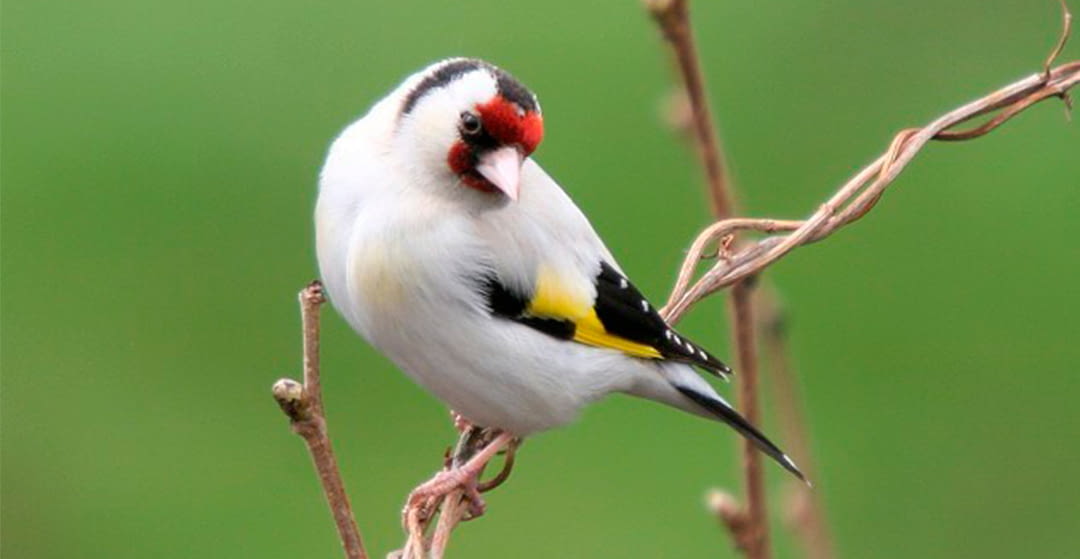
White goldfinches are undoubtedly prized pets thanks to their cheerful and captivating song, a quality that attracts bird lovers in search of charming companions.
However, to ensure their optimal health and well-being, it is crucial to meet certain requirements and provide them with special care. Its melodious trill and simplicity in its care are two essential aspects that have contributed to raising its status among the most appreciated species by bird enthusiasts.
White goldfinches have a unique feature: their white plumage. What distinguishes them from other colorful birds?
IS THE WHITE GOLDFISH AN ALBINO BIRD?
Have you ever wondered why the white goldfinch is so different from its vibrantly plumaged relatives? It turns out that this variety of goldfinch is the result of a fascinating genetic mutation that has captured the curiosity of bird watchers for generations.
This genetic mutation, which affects the expression of pigments in feathers, produces plumage that lacks coloration or has extremely low pigmentation. As a result, the white goldfinch stands out among its congeners for its unique and striking appearance.
But the uniqueness of the white goldfinch is not limited only to its plumage. This genetic mutation also affects the color of their eyes, which can present a lighter shade or even complete albinism.
However, despite its distinctive appearance, the white goldfinch retains many of the physical and behavioral characteristics of its more colorfully plumaged relatives. Typically sized between 12 and 14 cm in height, it shares the same compact and elegant size as its congeners.
In short, the white goldfinch is a fascinating example of how genetic mutations can lead to diversity in the animal kingdom. Its unique appearance and intriguing genetic origin make it a species worthy of study and admiration by bird lovers and scientists alike.
THE HABITAT
When preparing the space for a white goldfinch, cage choice is a key aspect to consider. This should offer enough space so that the bird can stretch its wings and fly comfortably. Depending on whether the goldfinch will live alone or in the company of others of its species, a suitable cage must be selected from our habitats that meets its social and space needs.
In addition to ensuring enough space to fly, the white goldfinch's cage must have elements that promote its well-being and stimulate its physical and mental activity. Along with feeders and waterers, it is advisable to include a variety of safe and stimulating toys to keep their mind active and prevent boredom.
Likewise, providing natural branches inside the cage will allow the white goldfinch to sharpen its nails naturally, thus promoting its foot health and general well-being. A swing can also be a much-appreciated accessory, providing your bird with a comfortable place to rest and swing.
In short, a spacious and well-equipped cage with toys, natural branches and other suitable elements will ensure an optimal environment for the white goldfinch, allowing it to lead an active and healthy life in captivity.
FEEDING
If any of your clients enjoys the company of this beautiful pet and asks you for advice on their diet. Here we present a complete list of foods that are part of a balanced and varied diet for these charming albino birds:
· Grains: Like most birds, white goldfinches benefit greatly from a mixture of grains in their diet. Canary seed, rapeseed, sesame, hempseed, oats, poppy or linseed can be included to ensure an adequate supply of essential nutrients.
· Fruits and vegetables: Although they are mainly granivores, incorporating fresh fruits and vegetables into their diet provides a vital supplement of vitamins and minerals. Pieces of lettuce, apple, tomato or pear are excellent options to maintain your health and vitality.
· Insects: Despite being in a domestic environment, white goldfinches can benefit from occasionally including insects in their diet and offering them as a tasty and nutritious treat.
By following these dietary guidelines, you are ensuring that the animal receives all the necessary nutrients to stay healthy and happy in addition to, obviously, always providing fresh, clean water to ensure adequate hydration.



